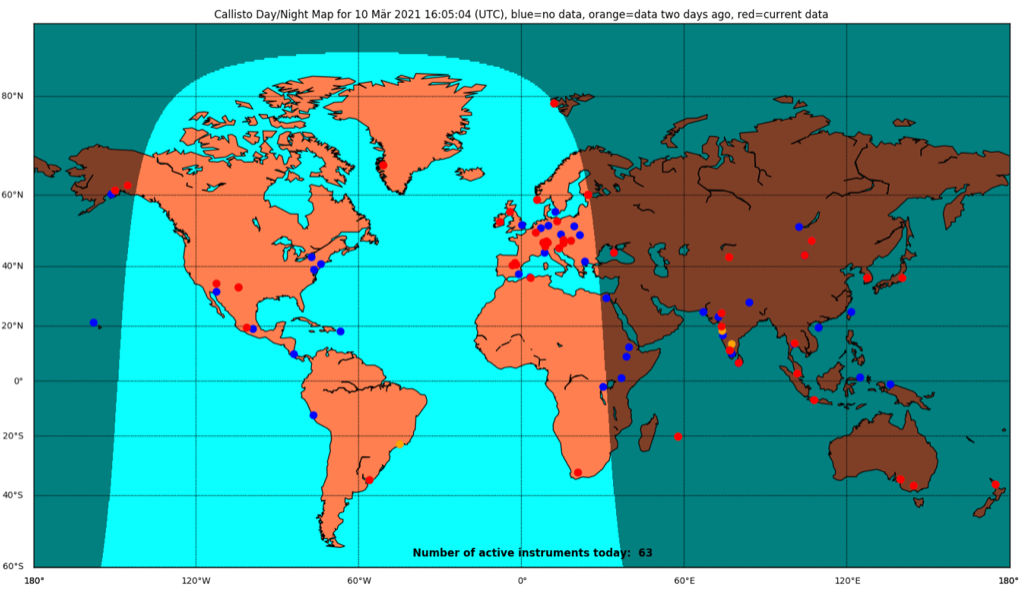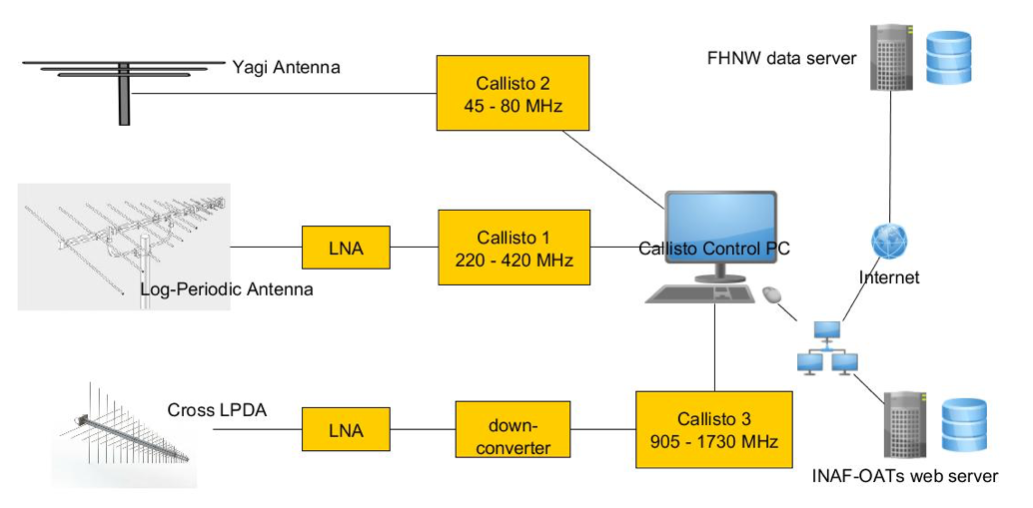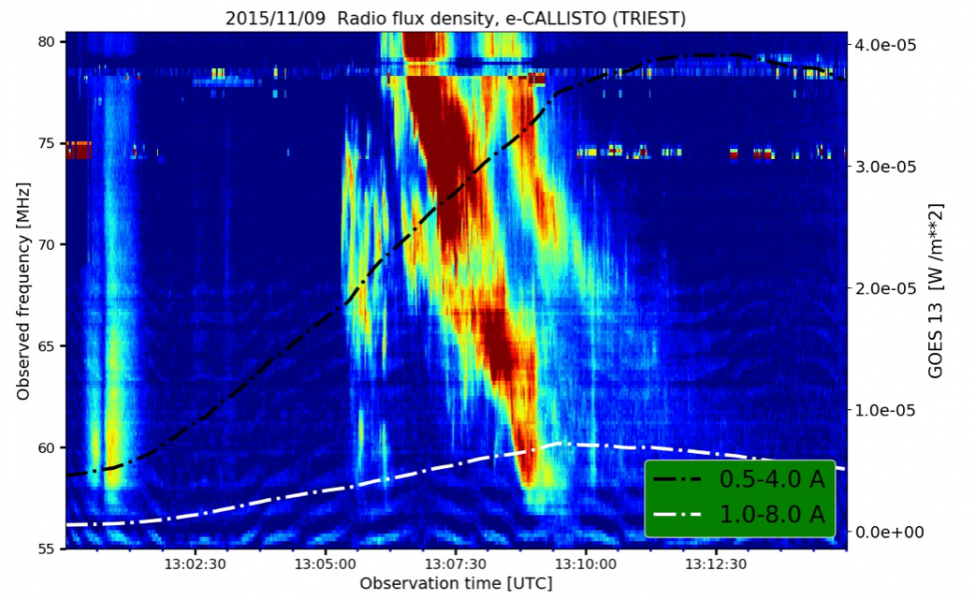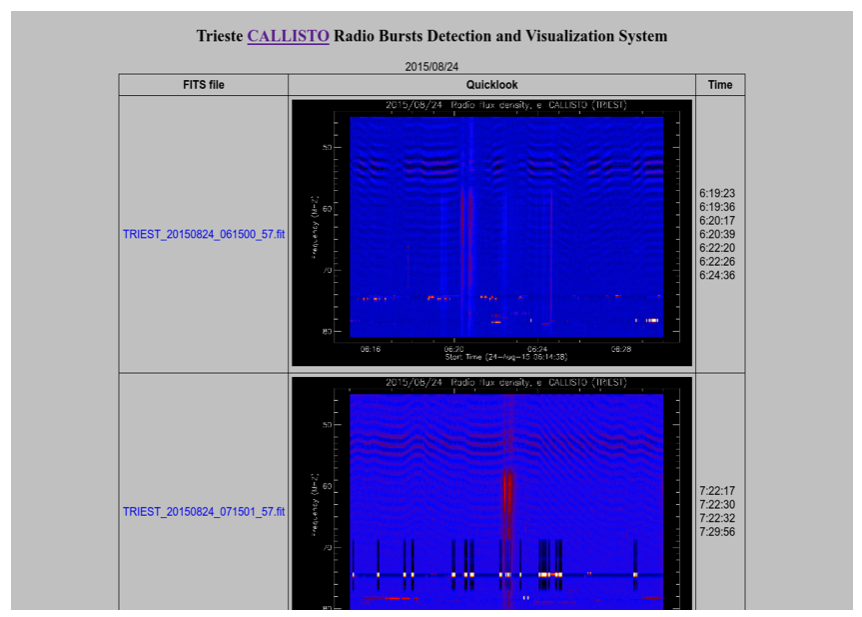A solar radio burst (SRB) is the intense solar radio emission often related to a solar flare and one of the possibly extreme space weather events which may affect Earth’s ionosphere and signal propagation, wireless communication, power grids and navigation systems. If an SRB occurs with the enhancement in L band radio flux, it could influence the Global Navigation Satellite Systems (GNSS) signals through direct radio wave interferences. The major space weather events like solar flares and coronal mass ejections are usually accompanied by solar radio bursts, which can be used for a real time space weather forecast (White, 2007).
They are classified into five main types (McLean and Labrum 1985 and others), largely based on how they appear in dynamic spectrum observations from radio spectrographs.
Several radio instruments have been devised to monitor solar radio activity, including interferometers, spectrometers and imaging-spectrometers (Zucca et al. 2012).
The CALLISTO spectrometer is a programmable heterodyne receiver designed at ETH Zurich, Switzerland (Benz et al. 2005) during 2006 in the framework of International Heliophysical Year (IHY2007) and International Space Weather Initiative (ISWI). CALLISTO is an acronym standing for ‘Compound Astronomical Low frequency Low cost Instrument for Spectroscopy and Transportable Observatory’.
A number of CALLISTO spectrometers are deployed worldwide and together form the e-Callisto network (Benz et al. 2009). A map of current distribution of e-Callisto instruments 10 March 2021 is shown in Figure 1.

Figure 1. Real-time map of current distribution of Callisto instruments 10 March 2021 16:05:04 UTC. One dot can represent up to 5 instruments.
In this paper we describe the Trieste CALLISTO station, the local e-Callisto network digital archive, Trieste CALLISTO Radio Bursts Detection and Visualization System available via web.

Figure 2. Trieste CALLISTO Station setup at Basovizza
The Trieste CALLISTO station (http://radiosun.oats.inaf.it) was established in 2012 at the Basovizza Observing Station (45°38’37” N, 13°52’34 E”, 398m above MSL) operated by the Italian National Institute for Astrophysics (INAF) – Astronomical Observatory of Trieste (Italy) to study solar radio bursts and the response of the Earth’s ionosphere and geomagnetic field.
Three CALLISTO spectrographs are currently installed at Trieste CALLISTO Station (see Figure 2), sampling the radio spectrum in the 45-80 MHz, 220-420 MHz and 905-1730 MHz bands with in total 600 frequency channels and a temporal resolution of 250 ms per sweep.
This configuration of CALLISTO receivers and the use of a 2-elements Yagi VHF I band antenna, a broadband 130-1000 MHz LPDA and a cross LPDA antenna using a frequency down-converter, designed and built by one of the authors, allows a good sampling of the spectra with a low-cost system. Since June 2012, a number of Type I, II, III, IV and V radio bursts have been detected (see example in Figure3), despite the site RFI level.

Figure 3. Type III (left) and type II burst (centre) with GOES X-ray flux data overlaid on the spectrogram
A specific website (http://radiosun.oats.inaf.it) has been set up to access Trieste CALLISTO Station local data (quicklooks/FIT files) by date together with National Oceanic and Atmospheric Administration NOAA solar events daily report and GOES X-RAY flux plot.
An experimental automatic radio burst detection system is active too. Its results are shown clicking the three buttons corresponding to the three different monitored frequency bands (see example screenshot in Figure 4): there are offered links to the FIT files of the spectrograms containing bursts, quicklooks and the bursts appearance times.

Figure 4. Results of automatic radio burst detection
Conclusions
Three CALLISTO spectrographs are currently installed at Trieste CALLISTO Station, sampling the radio spectrum in the 45-80 MHz, 220-420 MHz and 905-1730 MHz bands with in total 600 frequency channels and a temporal resolution of 250 ms per sweep.
Since June 2012, a number of Type I, II, III, IV and V radio bursts have been detected, despite the site RFI level. As an example, from 1st November 2020 to 14th October 2021 Trieste CALLISTO station recorded 122 bursts.
Some efforts to automatically detect solar radio bursts have been performed and a simple detection algorithm applied to Trieste CALLISTO station only is currently active and produces results affected by a number of false positives due to RFI. Other detection algorithms are currently being studied applied both to local data only and to several CALLISTO stations in order to overcome RFI and noise. A deep-learning detection algorithm is under development to detect lightning strikes recorded in the spectrograms, profiting from the large number of strikes in this area which could be used in the training and test sets.
As soon as possible L-band observations will be performed using a 3 meter dish, now under maintenance. This fact will improve the sensitivity and the S/N ratio, considering the narrow beam width of the dish tracking the Sun.
Based on a recent paper: A. Marassi and C. Monstein, 2022, Trieste CALLISTO station setup and observations of solar radio bursts, Advances in Space Research, 69, Pages 2589-2600 DOI: 10.1016/j.asr.2021.12.043
References
Benz, A.O., Monstein, C., Meyer, H., 2005. Callisto A New Concept for Solar Radio Spectrometers. Sol. Phys. 226, pp. 143 – 151
Benz, A.O., Monstein, C., Meyer, H., et al, 2009. A World-Wide Net of Solar Radio Spectrometers: e-CALLISTO. Earth Moon Planets 104, pp. 277 – 285.
McLean J., Labrum N.R., 1985. Solar Radiophysics, Studies of Emission from the Sun at Metre Wavelengths. Cambridge University Press, New York
Zucca, P., Carley, E.P., McCauley, J., et al, 2012. Observations of Low Frequency Solar Radio Bursts from the Rosse Solar-Terrestrial Observatory. Sol. Phys. 280(2), pp. 591–602
*Alessandro Marassia, Christian Monsteinb
aINAF – Astronomical Observatory of Trieste, via GiamBattista Tiepolo, 11 34143 Trieste (Italy), bIstituto Ricerche Solari (IRSOL), Università della Svizzera italiana (USI) CH-6605 Locarno-Monti (Switzerland)
